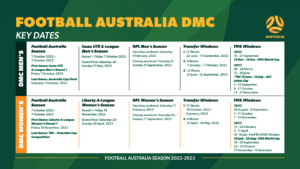
Football Australia has today released the Australian Football Domestic Match Calendar for 2022/23 (DMC 2022/23) which outlines the key dates for elite men’s and women’s football competitions, alongside transfer and registration windows, for the period from 7 October 2022 to 7 October 2023.
Designed and implemented to align the game and harmonise Australia with key international football events and activities, the DMC 2022/23 provides clear windows for matches from the Isuzu UTE A-League Men, Liberty A-League Women, Australia Cup, and National Premier Leagues (NPL) to be played, enabling administrators and teams to progress their planning for Australian football leagues and competitions accordingly.
Having extensively consulted with key stakeholders including Australian Professional Leagues (APL), Football Australia via the DMC 2022/23 has regulated that FIFA international windows for men’s and women’s football will be observed throughout 2022/23, with A-League Men’s and Women’s competitions to pause while the respective Australian senior national teams are in action.
To view the Australian Football Domestic Match Calendar for 2022/23, please click here.
This move will ensure that players selected for national team representation will not miss club matches during the periods in which they are on international duty, supporting an increase in match minutes for the individuals chosen to represent the Socceroos or Commonwealth Bank Matildas.

Football Australia Chief Executive Officer, James Johnson, explained that the DMC 2022/23 is a significant tool for Australian football that will help the game to capitalise on several major milestones over the coming year.
“With the Domestic Match Calendar 2022/23 now finalised, staff at Member Federations, the APL, and Football Australia, as well as clubs within the Australian football ecosystem, can more thoroughly plan their activities for the period from 7 October 2022 and 7 October 2023,” Johnson said via press release.
“There are many major milestones that the game can capitalise on over the next 12-to-18 months, with the tailwinds of Australia’s participation at this year’s FIFA World Cup™ in Qatar, and co-hosting of next year’s FIFA Women’s World Cup™, to help underpin interest in the A-Leagues, NPL competitions, and the Australia Cup.
“With clear windows for match activity now set, we can work collaboratively on maximising the opportunities that exist within player pathways, as well as think and act strategically about the promotion of the sport, ensuring that each area of the game has the best possible opportunity to engage fans, sponsors, and audiences both domestically and internationally.
“Pleasingly, we will see a significant amount of Australia Cup football prior to the commencement of the A-League Men season in early October. This could see our domestically-based Socceroos players being exposed to a good amount of competitive football prior to the FIFA World Cup™ in Qatar.”
“It has taken a collaborative, team effort to finalise the DMC 2022/23, and we acknowledge stakeholders from across the game for contributing to this important piece of work,” Johnson concluded.
Key dates/features of the DMC 2022/23 include:
- Isuzu UTE A-League Men’s 2022/23 Regular Season to commence from Friday, 7 October 2022, with the 2023 Grand Final to be contested on the weekend of 26-27 May 2023
- Liberty A-League Women’s 2022/23 Regular Season to commence from Friday, 18 November 2022, with the 2023 Grand Final to be contested on the weekend of 29-30 April 2023
- Final match of the DMC 2022/23 to feature the 2023 Australia Cup Final on Saturday, 7 October 2023
- National Premier Leagues 2023 Seasons to commence from Saturday, 4 February 2023 (men’s) and Saturday, 11 February 2023 (women’s) respectively
- Placeholder between March 2023 and September 2023 included for establishment of new National Second Tier competition (men’s)
- Player welfare windows included in both men’s and women’s calendars to ensure players can obtain rest/annual leave between seasons/elite football commitments
To view the Australian Football Domestic Match Calendar for 2022/23, please click here.





















